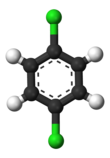1,4-Dichlorobenzene (1,4-DCB, p-DCB, or para-dichlorobenzene, sometimes abbreviated as PDCB or para) is an aryl chloride and isomer of dichlorobenzene with the formula C6H4Cl2. This colorless solid has a strong odor. The molecule consists of a benzene ring with two chlorine atoms (replacing hydrogen atoms) on opposing sites of the ring.
| |||
 1,4-dichlorobenzene crystallised on paper from DCM solution | |||
| Names | |||
|---|---|---|---|
| Preferred IUPAC name
1,4-Dichlorobenzene | |||
| Other names
1,4-DCB para-Dichlorobenzene p-Dichlorobenzene p-DCB PDCB Paramoth Para crystals Paracide Dichlorocide | |||
| Identifiers | |||
3D model (JSmol) |
|||
| 1680023 | |||
| ChEBI | |||
| ChEMBL | |||
| ChemSpider | |||
| ECHA InfoCard | 100.003.092 | ||
| EC Number |
| ||
| 49722 | |||
| KEGG | |||
PubChem CID |
|||
| RTECS number |
| ||
| UNII | |||
| UN number | 3077 | ||
CompTox Dashboard (EPA) |
|||
| |||
| |||
| Properties | |||
| C6H4Cl2 | |||
| Molar mass | 147.00 g·mol−1 | ||
| Appearance | Colorless/white crystals[1] | ||
| Odor | mothball-like[1] | ||
| Density | 1.25 g/cm3, solid | ||
| Melting point | 53.5 °C (128.3 °F; 326.6 K) | ||
| Boiling point | 174 °C (345 °F; 447 K) | ||
| 10.5 mg/100 mL (20 °C) | |||
| Vapor pressure | 1.3 mmHg (20 °C)[1] | ||
| -82.93·10−6 cm3/mol | |||
| Hazards | |||
| Occupational safety and health (OHS/OSH): | |||
Main hazards |
Suspected carcinogen | ||
| GHS labelling: | |||
   | |||
| Warning | |||
| H302, H315, H317, H319, H332, H335, H351, H410 | |||
| P201, P202, P261, P264, P270, P271, P272, P273, P280, P281, P301+P312, P302+P352, P304+P312, P304+P340, P305+P351+P338, P308+P313, P312, P321, P330, P332+P313, P333+P313, P337+P313, P362, P363, P391, P403+P233, P405, P501 | |||
| NFPA 704 (fire diamond) | |||
| Flash point | 66 °C (151 °F; 339 K) | ||
| Explosive limits | 2.5%-?[1] | ||
| Lethal dose or concentration (LD, LC): | |||
LD50 (median dose) |
500 mg/kg (rat, oral) 2950 mg/kg (mouse, oral) 2512 mg/kg (rat, oral) 2830 mg/kg (rabbit, oral)[2] | ||
LDLo (lowest published) |
857 mg/kg (human, oral) 4000 mg/kg (rat, oral) 2800 mg/kg (guinea pig, oral)[2] | ||
| NIOSH (US health exposure limits): | |||
PEL (Permissible) |
TWA 75 ppm (450 mg/m3)[1] | ||
REL (Recommended) |
Ca[1] | ||
IDLH (Immediate danger) |
Ca [150 ppm][1] | ||
| Related compounds | |||
Related compounds |
1,2-Dichlorobenzene 1,3-Dichlorobenzene | ||
Except where otherwise noted, data are given for materials in their standard state (at 25 °C [77 °F], 100 kPa).
| |||
It is used as a disinfectant, pesticide, and deodorant, most familiarly in mothballs in which it is a replacement for the more traditional naphthalene because of naphthalene's greater flammability (though both chemicals have the same NFPA 704 rating). It is also used as a precursor in the production of the chemically and thermally resistant polymer poly(p-phenylene sulfide).[3]
Production
p-DCB is produced by chlorination of benzene using ferric chloride as a catalyst:
- C6H6 + 2 Cl2 → C6H4Cl2 + 2 HCl
The chief impurity is the 1,2 isomer. The compound can be purified by fractional crystallization, taking advantage of its relatively high melting point of 53.5 °C; the isomeric dichlorobenzenes and chlorobenzene melt well below room temperature.[3]
Uses
Disinfectant, deodorant, and pesticide

p-DCB is used to control moths, molds, and mildew.[4] It also finds use as a disinfectant[3] in waste containers and restrooms and is the characteristic smell associated with urinal cakes. Its usefulness for these applications arises from p-DCB's low solubility in water and its relatively high volatility: it sublimes readily near room temperature.[3]
Precursor to other chemicals
Nitration gives 1,4-dichloronitrobenzene, a precursor to commercial dyes and pigments.[5] The chloride sites on p-DCB can be substituted with hydroxylamine and sulfide groups. In a growing application, p-DCB is the precursor to the high performance polymer poly(p-phenylene sulfide):[6]
Environmental and health effects
p-DCB is poorly soluble in water and is not easily broken down by soil organisms. Like many hydrocarbons, p-DCB is lipophilic and will accumulate in fatty tissues if consumed by a person or animal.
The United States Department of Health and Human Services (DHHS) and the International Agency for Research on Cancer (IARC) have determined that p-DCB may reasonably be anticipated to be a carcinogen.[7] This has been indicated by animal studies, although a full-scale human study has not been done.[8]
The United States Environmental Protection Agency (EPA) has set a target maximum contaminant level of 75 micrograms of p-DCB per liter of drinking water (75 μg/L),[9] but publishes no information on the cancer risk.[10] p-DCB is also an EPA-registered pesticide.[11] The United States Occupational Safety and Health Administration (OSHA) has set a maximum level of 75 parts of p-DCB per million parts air in the workplace (75 ppm) for an 8-hour day, 40-hour workweek.[12][13]
A mechanism for the carcinogenic effects of mothballs and some types of air fresheners containing p-DCB has been identified in roundworms.[14]
Due to its carcinogenic nature, use of paradichlorobenzene in the European Union is forbidden as an air freshener (since 2005) and in mothballs (since 2008).
Biodegradation
Rhodococcus phenolicus is a bacterium species able to degrade dichlorobenzene as its sole carbon source.[15]
See also
References
External links
Wikiwand in your browser!
Seamless Wikipedia browsing. On steroids.
Every time you click a link to Wikipedia, Wiktionary or Wikiquote in your browser's search results, it will show the modern Wikiwand interface.
Wikiwand extension is a five stars, simple, with minimum permission required to keep your browsing private, safe and transparent.




